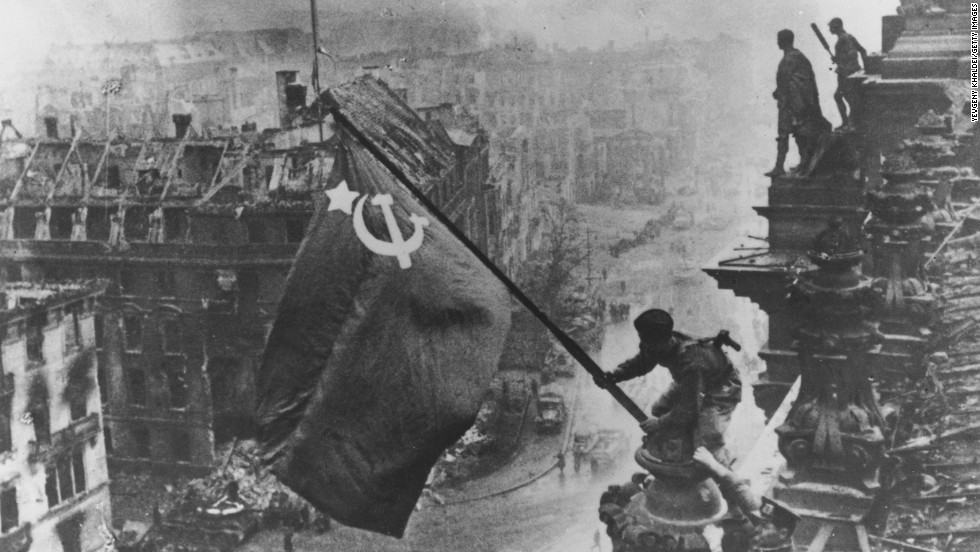German troops marching in Warsaw, Poland, in 1939. (Credit: FPG / Getty Images)
(CNN) -
This is a look at World War II, which lasted from 1939 to 1945.
Causes of World War II
The Peace of Paris -
The treaties drawn up in Paris at the end of the First World War did not satisfy many.
Germany, Austria, and the other countries on the losing side of the war were especially unhappy with the Paris Peace Conference, which required them to lay down their arms and make repairs.
Germany agreed to sign the Versailles Treaty only after the victorious countries threatened to invade it if it did not sign it: the last payment for reparations was made in 2010.
80 years of "Operation Barbarossa": the Nazi invasion of the Soviet Union during World War II
Economic issues -
The First World War was devastating for the economies of the countries.
Although the European economy had stabilized in the 1920s, the Great Depression in the United States caused economic decline in Europe.
Communism and fascism gained strength as a result of economic problems.
A soldier flies the flag of the Soviet Union in Berlin, Germany, on April 30, 1945.
Nationalism -
An extreme form of patriotism that grew in Europe became even stronger after World War I, especially for countries that were defeated.
Dictatorships -
Political unrest and unfavorable economic conditions led to the emergence of dictatorships in countries such as Germany, Italy, Japan, and the Soviet Union.
advertising
Appeasement Failure -
Czechoslovakia had become an independent nation after World War I, but by 1938 it was surrounded by much of German territory.
Hitler, dictator of Germany, wanted to annex the Sudetenland, an area in western Czechoslovakia where many Germans lived.
British Prime Minister Neville Chamberlain wanted to appease Hitler and agreed to his demands on the Sudetenland after he promised he would not demand more territory.
Germany seized the rest of Czechoslovakia in March 1939.
Axis Powers
Germany, Japan, and Italy formed a coalition called the Axis Powers.
Bulgaria, Hungary, Romania and two states created by Germany - Croatia and Slovakia - later joined.
Main actors:
Germany
- Adolf Hitler, Chancellor and "Führer" (guide or leader)
Japan
- Admiral Hideki Tojo, Prime Minister
Italy
- Benito Mussolini, Prime Minister
The ditators Benito Mussolini, from Italy, and Adolf Hitler, from Germany.
(Photo courtesy History LATAM)
Allied Powers
The United States, Great Britain, China and the Soviet Union made up the Allies, the group that fought against the Axis.
Between 1939 and 1944, at least 50 nations would eventually join the alliance.
Thirteen more nations would join in 1945, including: Australia, Belgium, Brazil, the British Commonwealth of Nations, Canada, India, New Zealand, South Africa, Czechoslovakia, Denmark, France, Greece, the Netherlands, Norway, Poland, the Philippines, and Yugoslavia. .
Main actors:
United States
- Franklin D. Roosevelt, President
Great Britain
- Winston Churchill, Prime Minister of
China
- Chiang Kai-Shek, General
Soviet Union
- Joseph Stalin, General
US Troop Statistics
16,112,566 - Number of US soldiers who served in the conflict.
670,846 - Number of wounded Americans.
American deaths
In battle: 291,557
Other causes: 113,842
Total in the theater of operations: 405,399
Pictured here are Soviet leader Joseph Stalin, US President Franklin D. Roosevelt, and British Prime Minister Winston Churchill in 1943 in Tehran, Iran.
(Credit: Hulton Deutsch / Corbis Historical / Getty Images)
Other military casualties by country (selection)
Australia
: 23,365 dead;
39,803 wounded
Austria
: 380,000 dead;
350,117 injured
Belgium
: 7,760 dead;
14,500 wounded
Bulgaria
: 10,000 dead;
21,878 injured
Canada
: 37,476 dead;
53,174 injured
China
: 2,200,000 dead;
1,762,000 injured
France
: 210,671 dead;
390,000 wounded
Germany
: 3,500,000 dead;
7,250,000 injured
Great Britain
: 329,208 dead;
348,403 wounded
Hungary
: 140,000 dead;
89,313 injured
Italy
: 77,494 dead;
120,000 wounded
Japan
: 1,219,000 dead;
295,247 injured
Poland
: 320,000 dead;
530,000 wounded
Romania
: 300,000 dead;
unknown wounded
Soviet Union:
7,500,000 dead;
5,000,000 wounded
United States:
405,399 dead;
670,846 injured
Other data
About 70 million people fought in the armed forces of the allied and Axis countries.
Finland never officially joined either the Allies or the Axis and was at war with the Soviet Union at the outbreak of World War II.
Needing help in 1940, the Finns joined Nazi Germany to repel the Soviets.
When peace was declared between Finland and the Soviet Union in 1944, Finland joined the Soviets in expelling the Germans.
Switzerland, Spain, Portugal and Sweden declared themselves neutral during the war.
A rescue ship recovers a sailor from the fire on the USS West Virginia during the Japanese attack on Pearl Harbor in 1941.
The Soviet Union was the one that lost more soldiers, more than seven million.
The number of civilian casualties from World War II may never be known.
Many deaths were caused by bombings, massacres, famine, and other war-related causes.
Six million Jews died in Nazi concentration camps during the war.
Hundreds of thousands of Roma and people with mental or physical disabilities also died.
The Lend and Lease Act was created to allow the United States to lend or lease weapons, equipment, or raw materials to any nation fighting the Axis.
Ultimately, 38 nations received some $ 50 billion in aid.
Most of it went to Britain and the Soviet Union.
In 1948, the United States created the Marshall Plan to help rebuild war-torn Europe.
Finally, 18 nations received $ 13 billion in food, machinery and other goods.
Japanese troops on the island of Chusan during the Sino-Japanese War, July 14, 1939.
In March 1974, Hiroo Onoda, a Japanese soldier still fighting the war, was found by a search party on the island of Lubang in the Philippines.
After his former commanding officer convinces him that the war is over, he is flown to Manila and formally surrenders to President Ferdinand Marcos.
Onoda died on January 16, 2014, at the age of 91.
Chronology
September 1, 1939 -
Germany invades Poland.
Denmark, Luxembourg, the Netherlands, Norway, Belgium, and France soon fall under German control.
June 10, 1940 -
Italy joins the conflict on Germany's side by declaring war against Great Britain and France.
The fighting extends to Greece and North Africa.
June 14, 1940 -
German troops enter Paris.
July 1940-September 1940 -
Germany and Great Britain wage an aerial war, the Battle of Britain, along the English coast.
September 7, 1940-May 1941 -
German night aerial bombardment campaign over London, known as the Blitz.
June 22, 1941 -
Germany invades the Soviet Union.
German tanks and soldiers attacking Soviet positions in 1941, during "Operation Barbarossa".
(Credit: FPG / Hulton Archive / Getty Images)
December 7, 1941 -
Japan attacks the US Navy base at Pearl Harbor, Hawaii, destroying more than half of the aircraft fleet and damaging all eight battleships.
Japan also attacks the Clark and Iba airfields in the Philippines, destroying more than half of the US military aircraft that were there.
December 8, 1941 - The
United States declares war on Japan.
Japan invades Hong Kong, Guam, the Wake Islands, Singapore, and British Malaya.
December 11, 1941 -
Germany and Italy declare war on the United States.
1942 -
The Allies stop the advance of the Axis Powers in North Africa and the Soviet Union.
February 1942 -
Japan invades the Malay Peninsula.
Singapore surrenders in a week.
June 4-6, 1942 -
Japan plans to invade the Hawaiian Islands, starting with Midway Island, but the United States cracks the mission code.
Japan attacks Midway and loses four aircraft carriers and more than 200 aircraft and pilots in America's first clear victory.
August 19, 1942 -
The Battle of Stalingrad begins as Germany moves into Russia.
August 1942-February 1943 -
US Marines fight and hold the island of Guadalcanal in the Pacific.
American soldiers landing on the beaches of Normandy, France, on June 6, 1944.
October 23, 1942 -
British troops force Axis troops to retreat to Tunisia after the second battle of El Alamein in Egypt.
February 1, 1943 -
German troops in Stalingrad surrender, partly defeated by the Soviet winter.
The defeat marks the cessation of the German advance to the east.
July 10, 1943 -
Allied forces land in Italy.
July 25, 1943 -
The King of Italy regains power and Mussolini is deposed and arrested.
November 1943-March 1944 -
US Marines invade the Solomon Islands at Bougainville to recapture them from the Japanese.
June 6, 1944 -
D-Day, in which Allied forces land on five Normandy beaches: Utah, Omaha, Gold, Juno, and Sword.
The landing includes more than 5,000 ships, 11,000 aircraft and more than 150,000 servicemen.
August 25, 1944 -
American and Free French forces liberate Paris.
January 27, 1945 -
Soviet troops liberate the Auschwitz camp complex, located near Krakow, Poland.
February 19-March 26, 1945 -
US Marines fight the Japanese over the island of Iwo Jima.
April 12, 1945 -
Roosevelt dies in Warm Springs, Georgia.
Vice President Harry Truman takes office as President.
April 25, 1945 -
Soviet troops surround Berlin.
April 28, 1945 -
Mussolini is assassinated while trying to escape to Switzerland.
April 29, 1945 -
US soldiers liberate the Dachau concentration camp, outside Munich, Germany.
Crowds gather in New York after President Harry S. Truman announced Japan's performance in World War II.
(Credit: Keystone / Getty Images)
April 30, 1945 -
Hitler and his wife Eva Braun commit suicide.
May 7, 1945 -
Germany accepts surrender in Reims (France), Eisenhower's headquarters.
Victory in Europe Day (VE) is celebrated on May 8 because it is the day the armistice went into effect.
May 8, 1945 -
VE Day.
The war in Europe is officially over.
July 16, 1945 -
First successful test of the atomic bomb in Alamogordo, New Mexico.
July 29, 1945 -
Truman warns Japan that the country will be destroyed if it does not surrender unconditionally.
Japan continues to fight.
A mushroom cloud billows over Hiroshima about an hour after the first atomic bomb was detonated.
At least 70,000 people died in the initial explosion.
(Credit: US Army / Hiroshima Peace Memorial Museum / AP)
August 6, 1945 -
The first atomic bomb used in the war, nicknamed Little Boy, is dropped on the Japanese city of Hiroshima, killing up to 140,000 people.
August 9, 1945 - With
no response from the Japanese government after the bombing of Hiroshima, a second atomic bomb, dubbed Fat Man, is dropped on Nagasaki, killing up to 80,000 people.
August 14, 1945 -
Japan unconditionally accepts the terms of the Potsdam Declaration and ends the war.
Victory Over Japan Day (VJ) is declared.
September 2, 1945 -
Japan signs the formal surrender aboard the USS Missouri in Tokyo Bay.
History World War II








